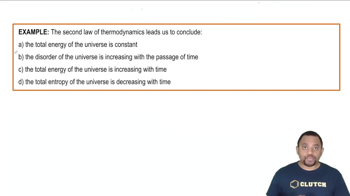Two different gases occupy the two bulbs shown here. Consider the process that occurs when the stopcock is opened, assuming the gases behave ideally. (d) How does the process affect the entropy of the surroundings?
Ch.19 - Chemical Thermodynamics
Chapter 19, Problem 3b
b. If energy can flow in and out of the system to maintain a constant temperature during the process, what can you say about the entropy change of the surroundings as a result of this process?
 Verified step by step guidance
Verified step by step guidance1
Identify the type of system and process: The system allows energy exchange to maintain constant temperature, indicating it's an isothermal process.
Understand the concept of entropy: Entropy is a measure of the disorder or randomness in a system. In thermodynamics, it's also a measure of energy dispersal at a specific temperature.
Relate energy flow and entropy: When energy flows out of the system (as heat) to maintain constant temperature, it increases the entropy of the surroundings because the energy is dispersed into a larger environment.
Apply the second law of thermodynamics: This law states that the total entropy of an isolated system can never decrease over time. Since the system is not isolated but can exchange heat with its surroundings, the entropy of the surroundings must increase if the system's entropy decreases or remains constant.
Conclude about the entropy change of the surroundings: Since the system maintains a constant temperature by exchanging heat with its surroundings, and based on the second law of thermodynamics, the entropy of the surroundings increases as a result of this process.

Verified video answer for a similar problem:
This video solution was recommended by our tutors as helpful for the problem above.
Video duration:
3mWas this helpful?
Key Concepts
Here are the essential concepts you must grasp in order to answer the question correctly.
Entropy
Entropy is a measure of the disorder or randomness in a system. In thermodynamics, it quantifies the amount of energy in a physical system that is not available to do work. When energy is transferred between a system and its surroundings, the change in entropy can indicate whether the process is spontaneous or requires external energy input.
Recommended video:
Guided course

Entropy in Thermodynamics
Thermodynamic Equilibrium
Thermodynamic equilibrium occurs when a system's macroscopic properties, such as temperature and pressure, are uniform throughout and do not change over time. In the context of the question, maintaining a constant temperature implies that the system is in thermal equilibrium with its surroundings, allowing for energy exchange without a net change in temperature.
Recommended video:
Guided course

First Law of Thermodynamics
Second Law of Thermodynamics
The Second Law of Thermodynamics states that the total entropy of an isolated system can never decrease over time. It implies that processes occur in a direction that increases the total entropy of the universe. In the scenario described, if energy flows in and out of the system while maintaining constant temperature, the entropy change of the surroundings will increase, reflecting the energy exchange and the tendency towards greater disorder.
Recommended video:
Guided course

Second Law of Thermodynamics Example
Related Practice
Textbook Question
627
views
Open Question
As shown here, one type of computer keyboard cleaner contains liquefied 1,1-difluoroethane (C2H4F2), which is a gas at atmospheric pressure. When the nozzle is squeezed, the 1,1-difluoroethane vaporizes out of the nozzle at high pressure, blowing dust out of objects. (d) Given your answers to (a), (b), and (c), do you think the operation of this product depends more on enthalpy or entropy? (a) Based on your experience, is the vaporization a spontaneous process at room temperature?
Textbook Question
Predict the signs of ΔH and ΔS for this reaction. Explain your choice.
611
views
Textbook Question
The accompanying diagram shows how entropy varies with temperature for a substance that is a gas at the highest temperature shown. (c) If this substance is a perfect crystal at T = 0 K, what is the value of S at this temperature?
492
views
Textbook Question
Isomers are molecules that have the same chemical formula but different arrangements of atoms, as shown here for two isomers of pentane, C5H12.
(a) Do you expect a significant difference in the enthalpy of combustion of the two isomers? Explain.
1524
views
1
rank
